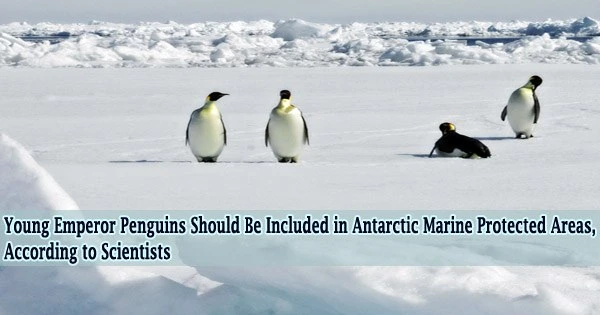As the U.S. Fish and Wildlife Service considers listing the species under the Endangered Species Act and the Commission for the Conservation of Antarctic Marine Living Resources (CCAMLR) considers expanding the network of Marine Protected Areas (MPAs) in the Southern Ocean, scientists at the Woods Hole Oceanographic Institution (WHOI) and European research institutions are calling for better protections for young emperor penguins.
The young birds spend nearly 90% of their time outside of existing and proposed MPAs, according to research published today in Royal Society Open Science, which is one of the rare long-term studies on juvenile emperor penguins and the only study focused on a colony on the Weddell Sea.
The research, which followed eight emperor penguins for a year using satellite tags, also discovered that they frequently ventured over 1,200 kilometers (745 miles) outside of the range for their species as established by the International Union for Conservation of Nature (IUCN), which is based on research on adult emperor penguins from a few other colonies.
Juvenile emperor penguins, who are regarded as immature until they are roughly 4 years old, are more susceptible than adults because they do not yet have fully matured foraging and predator avoidance skills.
The researchers came to the conclusion that significantly expanded MPAs are essential to save this iconic yet endangered penguin species at every life stage as sea-ice habitat is reduced by climate change and new regions of the Southern Ocean are made accessible to commercial fishing.
“While everyone is looking at the adult population, the juvenile population which leaves the relative safety of its parents at about five months is neither monitored nor protected,” said Dan Zitterbart, a WHOI associate scientist.
“The current and proposed MPAs in the Southern Ocean only include the range of adult emperor penguins, which do not travel as far as juveniles. From a conservation perspective, it’s important to know where these juveniles go. It’s one more piece of the puzzle to protect their marine habitat.”
“Emperor penguins have such low fecundity, if you do not protect juveniles, they may not ever become breeding adults,” he continued.
The Weddell Sea MPA design, as the other MPAs around Antarctica, should include the distribution at sea of all age-classes of the emperor penguin population not only the adults from a few study colonies. Juveniles are currently clearly lacking protection and their presence in the Northern waters needs to be considered in the future, especially regarding the development of fisheries in those regions.
Céline Le Bohec
Zitterbart and colleagues at the Centre Scientifique de Monaco (CSM), Centre National de la Recherche Scientifique (CNRS) and Université de Strasbourg in France, and the Alfred-Wegener Institute (AWI) in Germany are conducting a long-term monitoring study of the Atka Bay emperor penguin colony near Neumayer Station III, on the Weddell Sea.
One-third of established emperor penguin colonies are located in the Weddell Sea region, and studies have shown that these colonies, including those in the Ross Sea, are less susceptible to melting brought on by the climate than those in other parts of the Antarctic.
“Some of the Weddell Sea colonies are expected to still be present 50 to 100 years from now,” said Aymeric Houstin, a WHOI post-doctoral investigator and the lead author of the study. “It’s important to preserve colonies that will be able to endure climate change, as they could become a refuge for the entire population of emperor penguins.”
Studies show that less than 5% of the territory governed by CCAMLR is officially designated as a “no-take” area, whereas 13% of it is legally protected as an MPA.
The Weddell Sea MPA, first created by Germany and presented by the European Union in 2013, has been under consideration by the 26 members of CCAMLR for a number of years.
Although this MPA will protect one of the world’s most pristine ecosystems and a crucial region for global ocean circulation over an area of 2.2 million square kilometers (0.85 million square miles), the authors claim that the borders are insufficient to save young emperor penguins.
“The Weddell Sea MPA design, as the other MPAs around Antarctica, should include the distribution at sea of all age-classes of the emperor penguin population not only the adults from a few study colonies,” said Céline Le Bohec, of CNRS/Université de Strasbourg France and the Centre Scientifique de Monaco.
“Juveniles are currently clearly lacking protection and their presence in the Northern waters needs to be considered in the future, especially regarding the development of fisheries in those regions.”
The scientists intend to keep tagging adult and young penguins from the Atka Bay colony over the ensuing decades in order to monitor their travels and behavior as the environment changes.
Houstin argues that a “dynamic MPA,” based on forecasts of penguins’ annual travels, may be created with altering limits with more long-term data.
“This notion of a dynamic network of MPAs is really essential,” Le Bohec said. “It’s certainly the way to continue the dialogue with the fishing industry to ensure the resource is used in a sustainable manner, to ultimately preserve the unique biodiversity of these sensitive polar regions.”
















